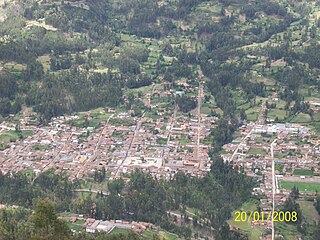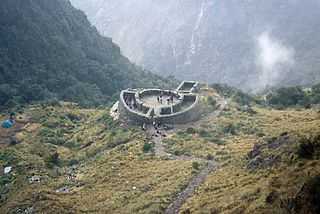
Pomabamba is the largest of 4 districts in the Pomabamba Province of the Ancash Region in Peru.

Chilcayoc or Ch'illkayuq is the smallest of 11 districts of the Sucre Province in the Ayacucho region in Peru.
The Ccatca District is one of the twelve districts in the Quispicanchi Province in Peru. Its capital is the town of Ccatca.
The Cusipata District is one of the twelve districts in the Quispicanchi Province in Peru. Created by Law No. 9164 on September 5, 1940, its capital is the town of Cusipata.
The Marcapata District is one of the twelve districts in the Quispicanchi Province in Peru. Created on January 20, 1869, its capital is Marcapata.

The Urcos District is one of the twelve districts in the Quispicanchi Province in Peru. Created on January 2, 1857, its capital is the town of Urcos. The closest airport is the TBP Airport which is located about 13.4 km north-east of Urcos. Urcos is southeast of the former Inca capital, Cusco, in the southern Andes, and it is at an altitude of 3,180 meters.
Ranracancha is one of the eight districts of the province Chincheros in Peru.
Cañaris District is one of six districts of the province Ferreñafe in Peru.
San Pedro District is one of eight districts of the province Canchis in Peru.
Quelloúno is one of ten districts of the La Convención Province in the Cusco Region in Peru.
Accha District is one of nine districts of the province Paruro in Peru.
Omacha District is one of nine districts of the province Paruro in Peru.
Caicay District is one of six districts of the province Paucartambo in Peru.

Maras District is one of seven districts of the Urubamba Province in Peru.

Singa or Sinqa is one of eleven districts of the province Huamalíes in Peru.

Chinchihuasi or Chinchi Wasi is one of ten districts of the Churcampa Province in Peru.
Isla Incahuasi, Inkawasi or Inka Wasi is a hilly and rocky outcrop of land and former island in Bolivia situated in the middle of Salar de Uyuni, the world's largest salt flat, at an elevation of 3,656 meters. It is located in the Potosí Department, Daniel Campos Province, Tahua Municipality, Yonza Canton. Isla Incahuasi is the Spanish name where isla means island, Inca stands for Inca, and huasi is derived from the Quechua word wasi meaning house.

Inka Wasi or Inkawasi is an archaeological site in Peru. It is located in the Ayacucho Region, Parinacochas Province, Pullo District.

Inka Wasi is an archaeological site in the Huancavelica Region in Peru. The Inca palace is considered one of the most important monuments of the Huancavelica Region. Inka Wasi is located in the Huaytará Province, Huaytará District, about 25 km from Huaytará. It is situated at a height of 3,804 m (12,480 ft).

Runkuraqay or Runku Raqay is an archaeological site on a mountain of the same name in Peru located in the Cusco Region, Urubamba Province, Machupicchu District. It is situated southeast of the archaeological site Machu Picchu and south of the Vilcanota river. The ruins lie on the southern slope of the mountain Runkuraqay near the Runkuraqay pass, northeast of the archaeological site Sayacmarca and southeast of the site Qunchamarka.
















